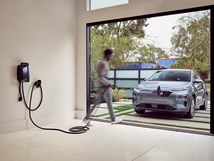Uber, Volvo Unveil “Production-Ready” Autonomous Car
Volvo Car Corp. and ride-hailing giant Uber Technologies Inc. took the wraps off the latest version of their jointly developed prototype self-driving vehicle.
Volvo Car Corp. and ride-hailing giant Uber Technologies Inc. took the wraps off the latest version of their jointly developed prototype self-driving vehicle.

The partners claim the modified Volvo XC90 SUV is the first model—with original-equipment wiring and harnessing—capable of fully driving itself. The vehicle features a roof-mounted sensor array, Uber’s control technology and backup devices are built into the braking, steering and battery systems.
Uber aims to begin testing the vehicles on public roads next year. The company will continue to test earlier self-driving XC90s that have been developed with Volvo over the last three years.
Volvo also aims to launch its own self-driving technology early next decade. These models will use the company’s SPA2 platform, which is being designed to accommodate autonomous driving on highways and other select roads.
Volvo anticipates that one-third of all new passenger vehicles produced will be fully autonomous by about 2025. This is a much more ambitious timeline than other industry forecasts for the technology.
Watch a video about the new Uber-Volvo vehicle HERE.
RELATED CONTENT
-
The Koenigsegg Jesko Has An Amazing Engine
It is hard to believe that this is a vehicle in “serial” production with such extraordinary powertrain performance
-
Plastics: The Tortoise and the Hare
Plastic may not be in the news as much as some automotive materials these days, but its gram-by-gram assimilation could accelerate dramatically.
-
Cobots: 14 Things You Need to Know
What jobs do cobots do well? How is a cobot programmed? What’s the ROI? We asked these questions and more to four of the leading suppliers of cobots.








